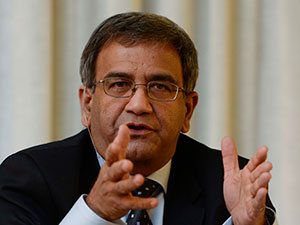
[miningmx.com] – ANGLOGOLD Ashanti has set itself a $1bn debt reduction target over the next three years and may ‘call’ its high-yielding $1.25bn bond, which matures in 2020, in 2016. Net debt currently stands at $2.9bn.
“Our objective is to reduce debt and interest charges so naturally we will go to the debt with the highest interest charge,” said Srinivasan Venkatakrishnan (Venkat). He was responding to questions during the firm’s third quarter results press briefing today.
AngloGold has four bonds that mature between 2020 and 2040 totalling R3bn. Of these, there is a R1.25bn bond maturing in 2020 that carries an 8.5% interest charge. Venkat said the company could ‘call’ or settle this bond although he added: “We would not rule out taking other debt out of the system”.
AngloGold said, however, in its quarterly report – in which normalised adjusted headline earnings for the period fell $44m quarter-on-quarter to $66m – that the reduction in net debt over the last few quarters had been “marginal”.
“Net debt increased to about $3.15bn as a result of capital spend ($8,3bn), but it has come down steadily by $150m [this year],” said Venkat. He added there would be some “lumpy costs” in the fourth quarter partly related to retrenchment payouts at Obuasi.
Given that he has virtually ruled out returning to the market for cash, this almost makes asset sales or joint ventures a nailed-on certainty as AngloGold seeks to give momentum to its ‘self-help’ strategy of continuing to strip out operating costs.
Potential partners in AngloGold assets would either ‘farm in’ or pay for a share upfront which would mean AngloGold would not be spending money on the assets which it believes will be a major spur to cash flow.
Generating free cash appears to be a struggle with some $30m generated in the third quarter following cash inflow of $320m – only $1m more than the corresponding quarter in its 2013 financial year, although that was generated at a higher gold price.
Obuasi, in Ghana, and two Colombia assets – Colosa and a newly discovered copper/gold deposit called Nuevo Chaquiro – are the most likely targets for and outright or partial sale.
Venkat said he had received a number of ‘reverse inquiries’ for Obuasi. “That’s where you don’t dial, the phone rings,” he said.
Obuasi was unique in that it was an eight million ounce high-grade reserve, with good infrastructure and labour relations, an ore reserve development that could be mechanised, said Venkat. “People can see AngloGold has done the heavy lifting,” he said.
Venkat warned, however, that assets would only be sold for value. “The shop isn’t open for bargain hunters,” he said.
PRODUCTION
AngloGold said it would produce at the upper end of its 4.2 million oz to 4.45m oz guidance in its 2014 despite having sold Navachab, the Namibian mine. Venkat said it was the first time it had lifted its production guidance “in my living memory”.
All-in Sustaining Costs would remain stable at between $1,025 to $1,075/oz for the financial year although cash costs would be higher than first guided. The group’s year-end closes on December 31.
For the 2015 financial year, however, containing mining-related inflation would require cost improvements of 8%. “This is how fast we need to run just to stay still on the escalator,’ said Venkat. As a result, there’s the possibility of another round of retrenchments at AngloGold.
Head of the group’s South African business, Mike O’Hare, said there would be a consolidation of services of the local assets. This was after discovering a duplication of costs at the regional and corporate level.
“The restructure won’t affect production levels; it is about services to the mines,” said O’Hare in response to questions from analysts. “The details not discussed widely across organisation so I need to do that first,” he said.
“We expect the stock to trade up following today’s announcement,” said Goldman Sachs in a morning note. “However, the recent weakness in gold prices could be a near term headwind,” it said.
Shares in the company were up just over 5% on the Johannesburg Stock Exchange in the first few hours of trade on November 3.










